Spatio-Temporal Variability in North Atlantic Oscillation Monthly Rainfall Signatures in Great Britain
Abstract
1. Introduction
- Assess the statistical significance and consistency of NAO-rainfall spatial signatures.
- Establish the spatial distribution of consistent or variable monthly NAO-rainfall responses.
2. Materials and Methods
2.1. Data
2.2. Calculation of Monthly Average SPI-1 Values
2.3. Space-Time Data Array
2.4. Space-Time Hot Spot Analysis (Getis Ord Gi* Statistic)
2.5. Space-Time Clustering Analysis
3. Results
3.1. Average Monthly SPI-1 Values
3.2. Space-Time Hot Spot Results
3.3. Space-Time Clustering Results
3.4. Examples of Consistent Monthly NAO-Rainfall Responses
3.5. Examples of Variable Monthly NAO-Rainfall Responses
4. Discussion
5. Conclusions
Author Contributions
Funding
Institutional Review Board Statement
Informed Consent Statement
Conflicts of Interest
Appendix A
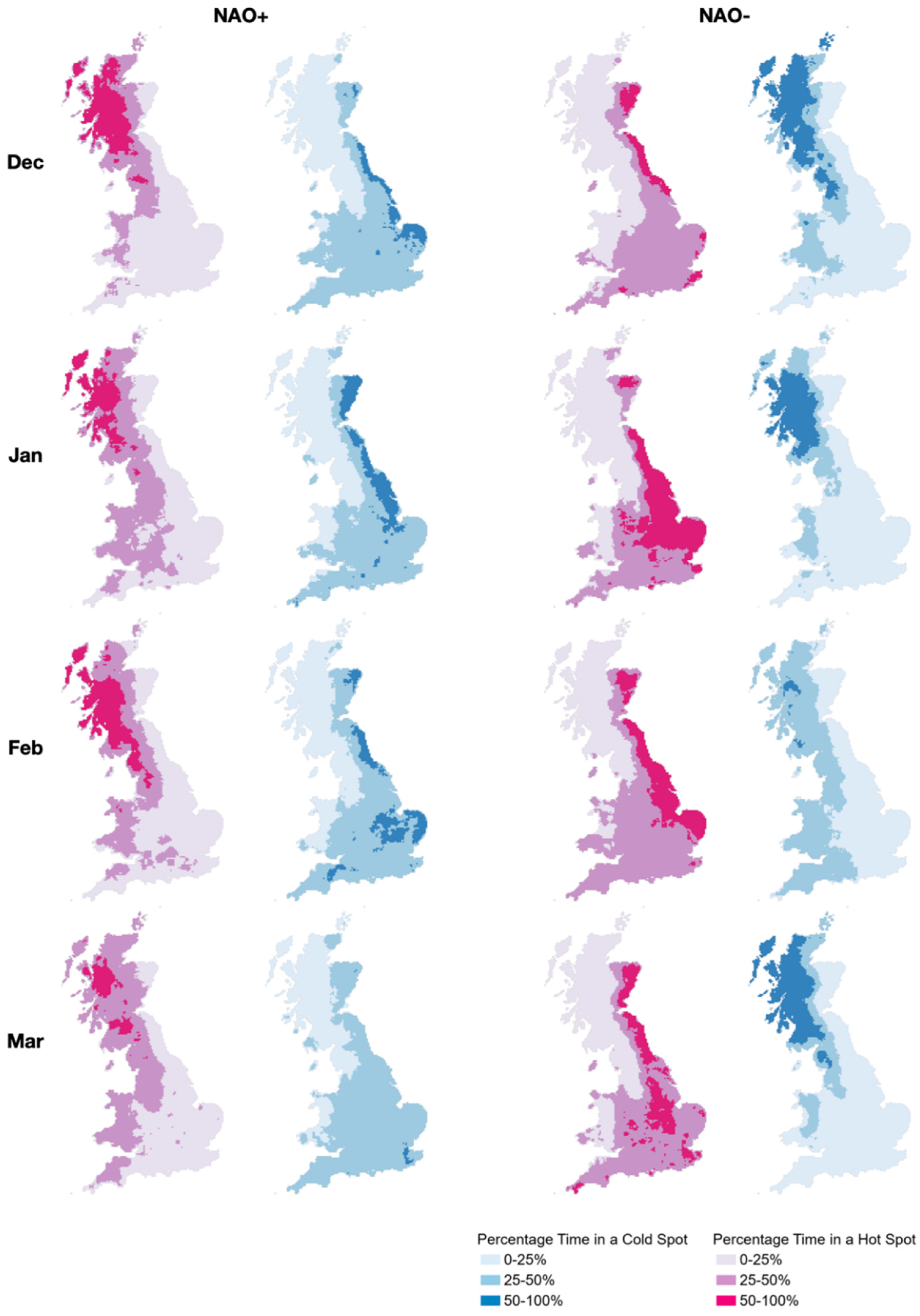
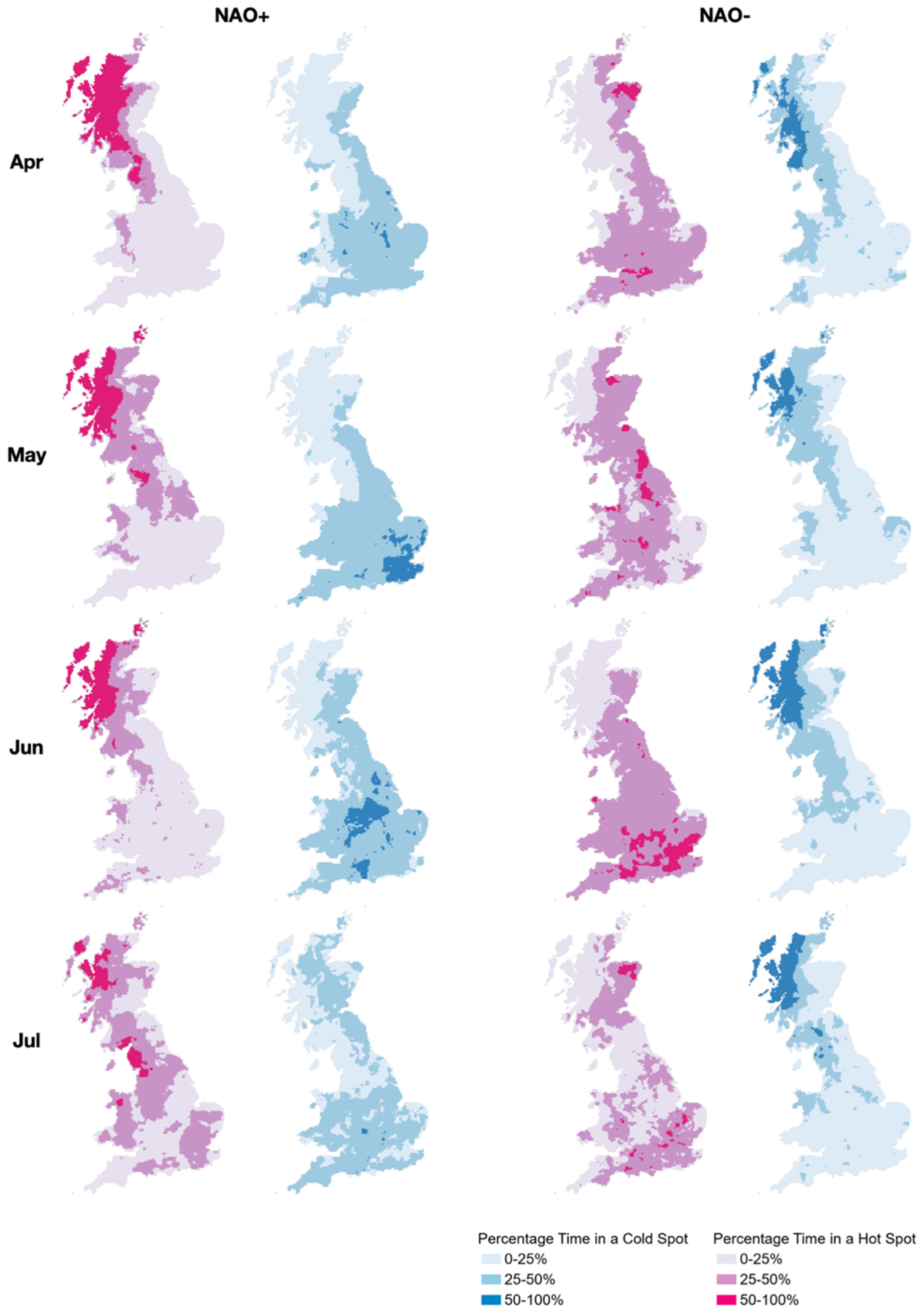
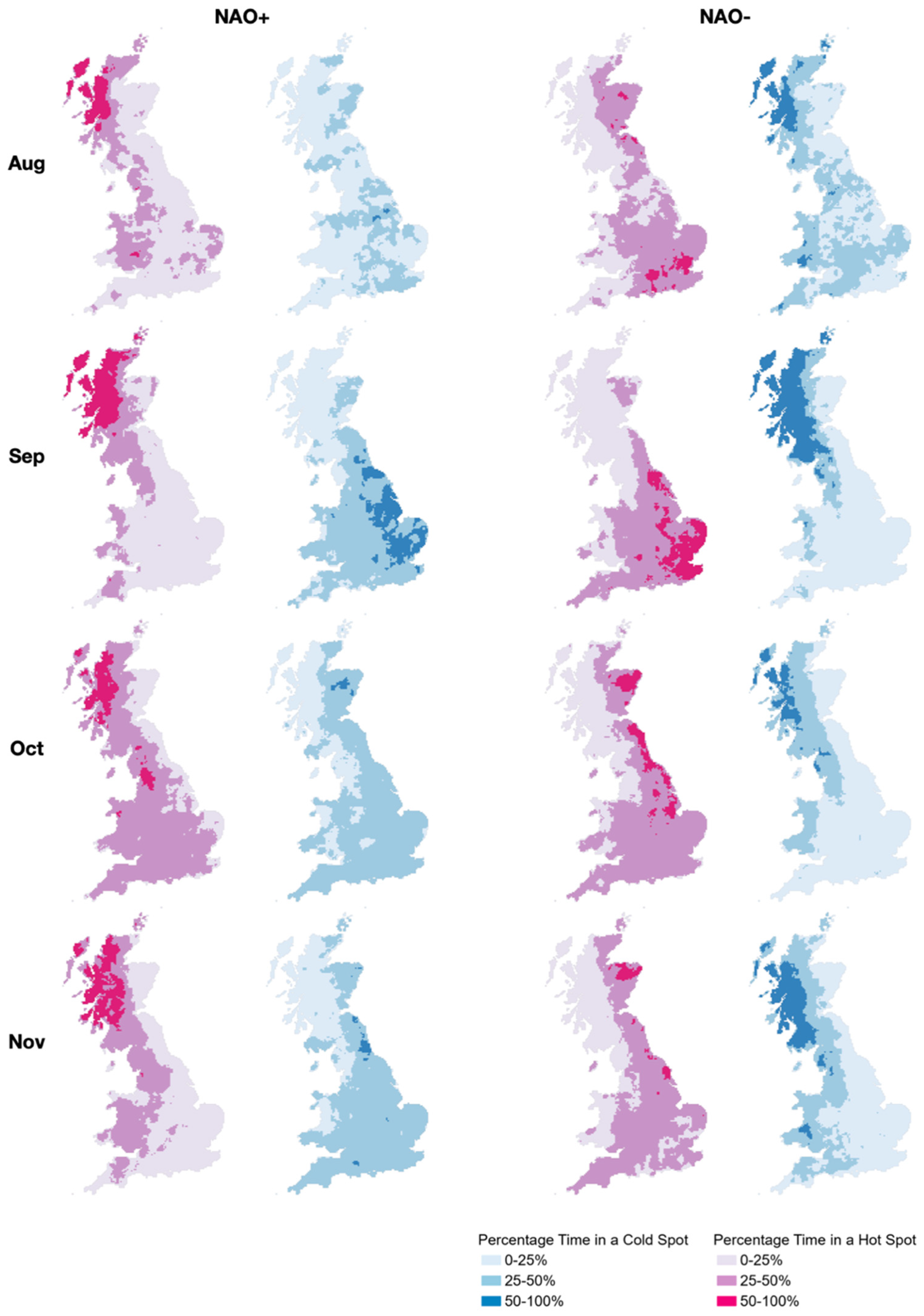
References
- Wilby, R.L.; O’Hare, G.; Barnsley, N. The North Atlantic Oscillation and British Isles climate variability, 1865–1996. Weather 1997, 52, 266–276. [Google Scholar] [CrossRef]
- Rodwell, M.J.; Rowell, D.P.; Folland, C.K. Oceanic forcing of the wintertime North Atlantic Oscillation and European climate. Nature 1999, 398, 320–323. [Google Scholar] [CrossRef]
- Hurrell, J.W.; Kushnir, Y.; Ottersen, G.; Visbeck, M. An overview of the North Atlantic Oscillation. In The North Atlantic Oscillation: Climatic Significance and Environmental Impact; American Geophysical Union: Washington, DC, USA, 2003; Volume 134, pp. 1–35. [Google Scholar]
- Woollings, T.; Czuchnicki, C.; Franzke, C. Twentieth century North Atlantic jet variability. Q. J. R. Meteorol. Soc. 2013, 140, 783–791. [Google Scholar] [CrossRef]
- Folwer, H.J.; Kilsby, C.G. Precipitation and the North Atlantic Oscillation: A study of climatic variability in Northern England. Int. J. Climatol. 2002, 22, 843–866. [Google Scholar]
- Afzal, M.; Gagnon, A.S.; Mansell, M.G. Changes in the variability and periodicity of precipitation in Scotland. Theor. Appl. Climatol. 2015, 119, 135–159. [Google Scholar] [CrossRef]
- Rust, W.; Holman, I.; Corstanje, R.; Bloomfield, J.; Cuthbert, M. A conceptual model for climatic teleconnection signal control on groundwater variability in Europe. Earth Sci. Rev. 2018, 177, 164–174. [Google Scholar] [CrossRef]
- Simpson, I.R.; Jones, P.D. Analysis of UK precipitation extremes derived from Met Office gridded data. Int. J. Climatol. 2013, 34, 2438–2449. [Google Scholar] [CrossRef]
- Kosanic, A.; Harrison, S.; Anderson, K.; Kavcic, I. Present and historical climate variability in South West England. Clim. Chang. 2014, 124, 221–237. [Google Scholar] [CrossRef]
- West, H.; Quinn, N.W.; Horswell, M. Regional rainfall response to the North Atlantic Oscillation (NAO) across Great Britain. Hydrol. Res. 2019, 50, 1549–1563. [Google Scholar] [CrossRef]
- Spencer, M.; Essery, R. Scottish snow cover dependence on the North Atlantic Oscillation index. Hydrol. Res. 2016, 47, 619–629. [Google Scholar] [CrossRef]
- Folland, C.K.; Knight, J.; Linderholm, H.W.; Fereday, D.; Ineson, S.; Hurrell, J.W. The Summer North Atlantic Oscillation: Past, Present, and Future. J. Clim. 2009, 22, 1082–1103. [Google Scholar] [CrossRef]
- Hall, R.J.; Hanna, E. North Atlantic circulation indices: Links with summer and winter UK temperature and precipitation and implications for seasonal forecasting. Int. J. Climatol. 2018, 38, e660–e677. [Google Scholar] [CrossRef]
- Phillips, I.D.; McGregor, G.; Wilson, C.J.; Bower, D.; Hannah, D. Regional climate and atmospheric circulation controls on the discharge of two British rivers, 1974?97. Theor. Appl. Climatol. 2003, 76, 141–164. [Google Scholar] [CrossRef]
- Rust, W.; Cuthbert, M.; Bloomfield, J.; Corstanje, R.; Howden, N.; Holman, I. Exploring the role of hydrological pathways in modulating North Atlantic Oscillation. Hydrol. Earth Syst. Sci. 2021, 25, 2223–2237. [Google Scholar] [CrossRef]
- Burt, T.P.; Howden, N.J.K. North Atlantic Oscillation amplifies orographic precipitation and river flow in upland Britain. Water Resour. Res. 2013, 49, 3504–3515. [Google Scholar] [CrossRef]
- Lavers, D.A.; Hannah, D.; Bradley, C. Connecting large-scale atmospheric circulation, river flow and groundwater levels in a chalk catchment in southern England. J. Hydrol. 2015, 523, 179–189. [Google Scholar] [CrossRef]
- Rust, W.; Holman, I.; Bloomfield, J.; Cuthbert, M.; Corstanje, R. Understanding the potential of climate teleconnections to project future groundwater drought. Hydrol. Earth Syst. Sci. 2019, 23, 3233–3245. [Google Scholar] [CrossRef]
- Wilby, R.; Johnson, M. Climate variability and implications for keeping rivers cool in England. Clim. Risk Manag. 2020, 30, 100259. [Google Scholar] [CrossRef]
- UK Hydrological Outlook. UK Hydrological Outlook December 2020. Available online: http://www.hydoutuk.net/files/2816/0743/4122/2020_12_HO_Complete.pdf (accessed on 14 December 2020).
- Donegan, S.; Murphy, C.; Harrigan, S.; Broderick, C.; Golian, S.; Knight, J.; Matthews, T.; Prudhomme, C.; Quinn, D.F.; Scaife, A.A.; et al. Conditioning Ensemble Streamflow Prediction with the North Atlantic Oscillation improves skill at longer lead times. Hydrol. Earth Syst. Sci. In Review. [CrossRef]
- Comas-Bru, L.; McDermott, F. Impacts of the EA and SCA patterns on European twentieth century NAO−winter climate rela-tionship. Q. J. R. Meteorol. Soc. 2014, 140, 354–363. [Google Scholar] [CrossRef]
- Mellado-Cano, J.; Barriopedro, D.; García-Herrera, R.; Trigo, R.M.; Hernández, A. Examining the North Atlantic Oscillation, East Atlantic Pattern, and Jet Variability since 1685. J. Clim. 2019, 32, 6285–6298. [Google Scholar] [CrossRef]
- Weisheimer, A.; Schaller, N.; O’Reilly, C.; MacLeod, D.A.; Palmer, T. Atmospheric seasonal forecasts of the twentieth century: Multi-decadal variability in predictive skill of the winter North Atlantic Oscillation (NAO) and their potential value for extreme event attribution. Q. J. R. Meteorol. Soc. 2017, 143, 917–926. [Google Scholar] [CrossRef] [PubMed]
- Parker, T.; Woollings, T.; Weisheimer, A.; O’Reilly, C.; Baker, L.; Shaffrey, L. Seasonal Predictability of the Winter North Atlantic Oscillation from a Jet Stream Perspective. Geophys. Res. Lett. 2019, 46, 10159–10167. [Google Scholar] [CrossRef]
- Athanasiadis, P.J.; Yeager, S.; Kwon, Y.-O.; Bellucci, A.; Smith, D.W.; Tibaldi, S. Decadal predictability of North Atlantic blocking and the NAO. npj Clim. Atmos. Sci. 2020, 3, 1–10. [Google Scholar] [CrossRef]
- Smith, D.M.; Scaife, A.A.; Eade, R.; Athanasiadis, P.; Bellucci, A.; Bethke, I.; Bilbao, R.; Borchert, L.F.; Caron, L.-P.; Counillon, F.; et al. North Atlantic climate far more predictable than models imply. Nature 2020, 583, 796–800. [Google Scholar] [CrossRef]
- Pokorná, L.; Huth, R. Climate impacts of the NAO are sensitive to how the NAO is defined. Theor. Appl. Clim. 2015, 119, 639–652. [Google Scholar] [CrossRef]
- National Centre for Atmospheric Research. Hurrell North Atlantic Oscillation Index (PC-Based). Available online: https://climatedataguide.ucar.edu/climate-data/hurrell-north-atlantic-oscillation-NAO−index-pc-based (accessed on 30 June 2020).
- Berton, R.; Driscoll, C.T.; Adamowski, J.F. The near-term prediction of drought and flooding conditions in the northeastern United States based on extreme phases of AMO and NAO. J. Hydrol. 2017, 553, 130–141. [Google Scholar] [CrossRef]
- Tanguy, M.; Fry, M.; Svensson, C.; Hannaford, J. Historic Gridded Standardized Precipitation Index for the United Kingdom 1862–2015 (Generated using Gamma Distribution with Standard Period 1961–2010) v4; NERC Environmental Information Data Centre: Wallingford, UK, 2017. [Google Scholar]
- Irannezhad, M.; Haghighi, A.T.; Chen, D.; Klöve, B. Variability in dryness and wetness in central Finland and the role of teleconnection patterns. Theor. Appl. Climatol. 2014, 122, 471–486. [Google Scholar] [CrossRef]
- Kingston, D.G.; Stagge, J.H.; Tallaksen, L.M.; Hannah, D.M. European-Scale Drought: Understanding Connections between Atmospheric Circulation and Meteorological Drought Indices. J. Clim. 2015, 28, 505–516. [Google Scholar] [CrossRef]
- Djellouli, F.; Bouanani, A.; Babahamed, K. Climate change: Assessment and monitoring of meteorological and hydrological drought of Wadi El Hamman Basin (NW–Algeria). J. Fundam. Appl. Sci. 2016, 8, 1037–1053. [Google Scholar] [CrossRef]
- Getis, A.; Ord, J.K. The Analysis of Spatial Association by Use of Distance Statistics. Geogr. Anal. 2010, 24, 189–206. [Google Scholar] [CrossRef]
- Esri. Hot Spot Analysis (Getis-Ord Gi*). Available online: https://pro.arcgis.com/en/pro-app/latest/tool-reference/spatial-statistics/hot-spot-analysis.htm (accessed on 4 February 2021).
- Ord, J.K.; Getis, A. Local Spatial Autocorrelation Statistics: Distributional Issues and an Application. Geogr. Anal. 1995, 27, 286–306. [Google Scholar] [CrossRef]
- Scott, L.; Warmerdam, N. Extended Crime Analysis with ArcGIS Spatial Statistics Tools. Available online: https://www.esri.com/news/arcuser/0405/ss_crimestats1of2.html (accessed on 4 February 2021).
- Esri. Space Time Cluster Analysis. Available online: https://pro.arcgis.com/en/pro-app/tool-reference/spatial-statistics/space-time-analysis.htm (accessed on 6 August 2020).
- Rust, W.; Bloomfield, J.P.; Cuthbert, M.O.; Corstanje, R.; Holman, I.P. Non-stationary control of the NAO on European rainfall and its implications for water resource management. Hydrol. Process. 2021, 35, e14099. [Google Scholar] [CrossRef]
- Casanueva, A.; Rodríguez-Puebla, C.; Frías, M.D.; González-Reviriego, N. Variability of extreme precipitation over Europe and its relationships with teleconnection patterns. Hydrol. Earth Syst. Sci. 2014, 18, 709–725. [Google Scholar] [CrossRef]
- Hurrwll, J.W.; Deser, C. North Atlantic climate variability: The role of the North Atlantic Oscillation. J. Mar. Syst. 2009, 78, 28–41. [Google Scholar] [CrossRef]
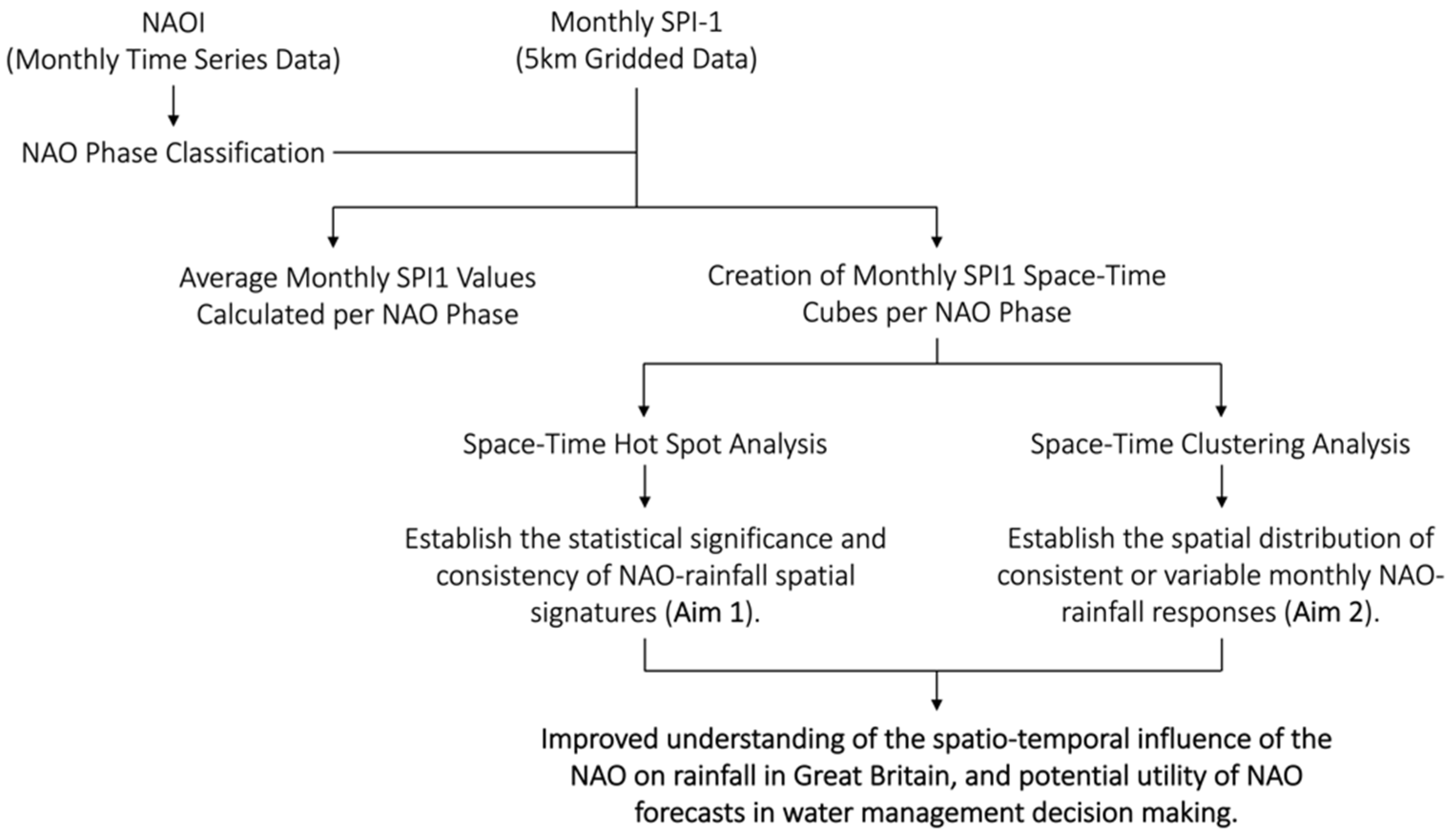
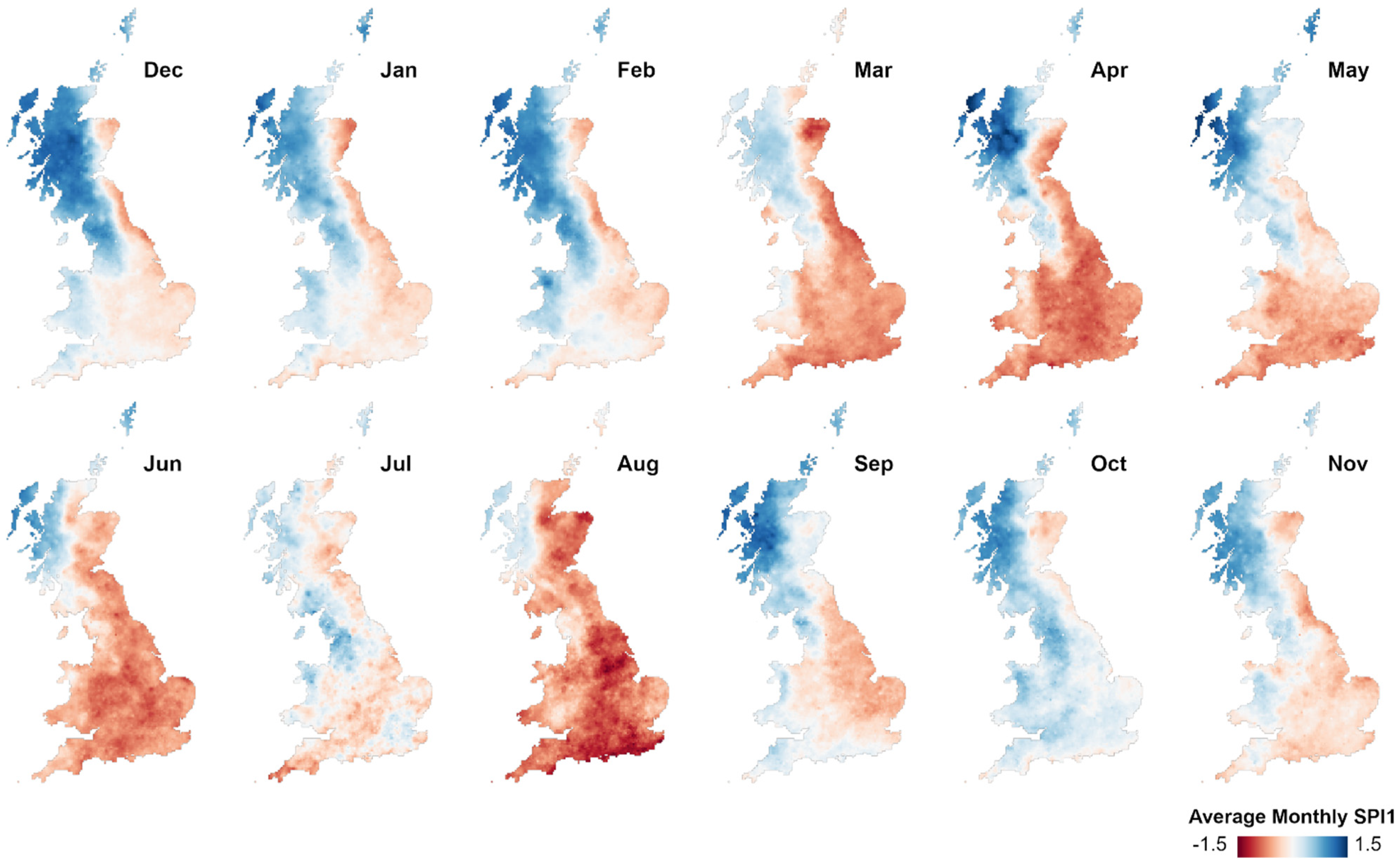
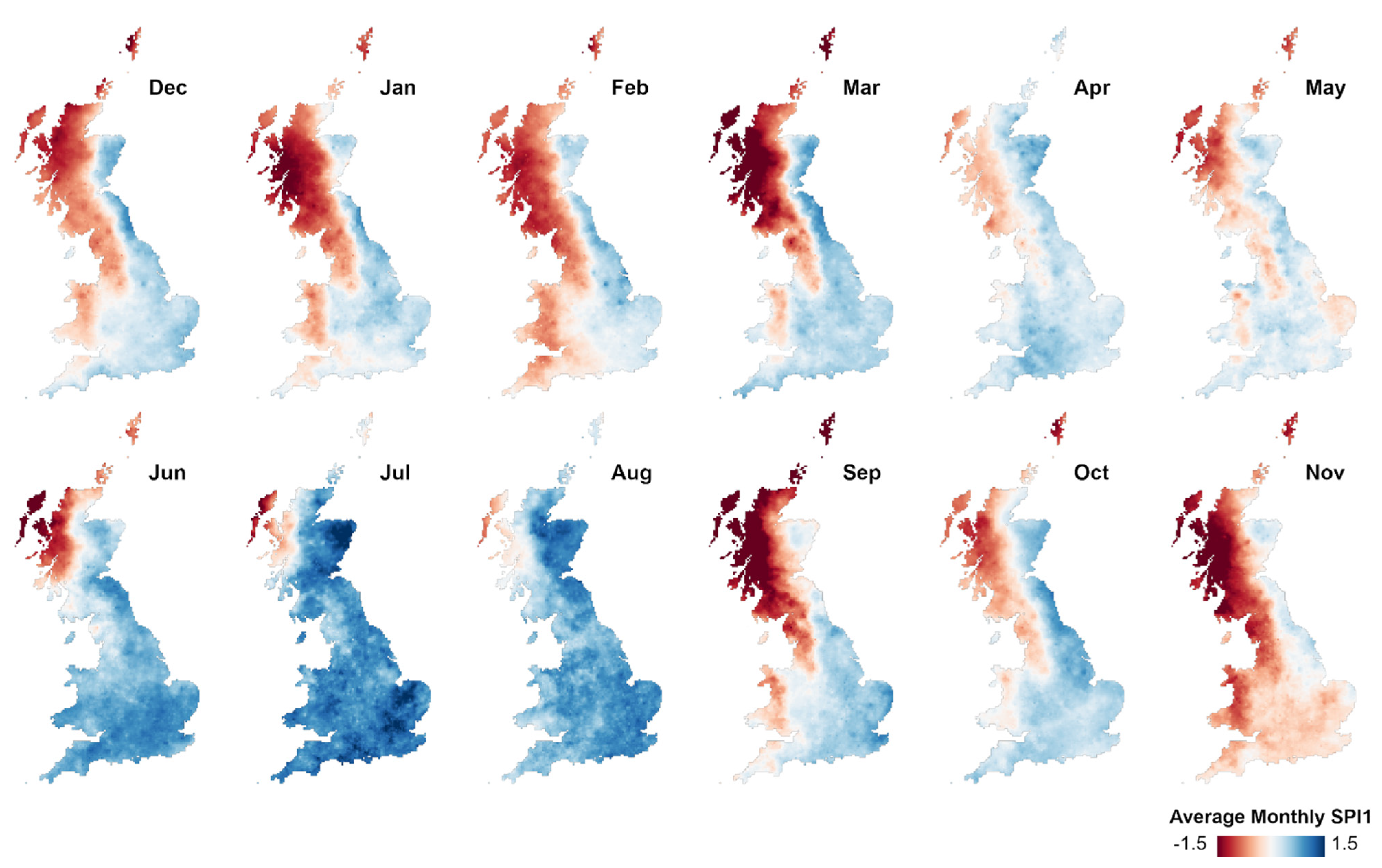
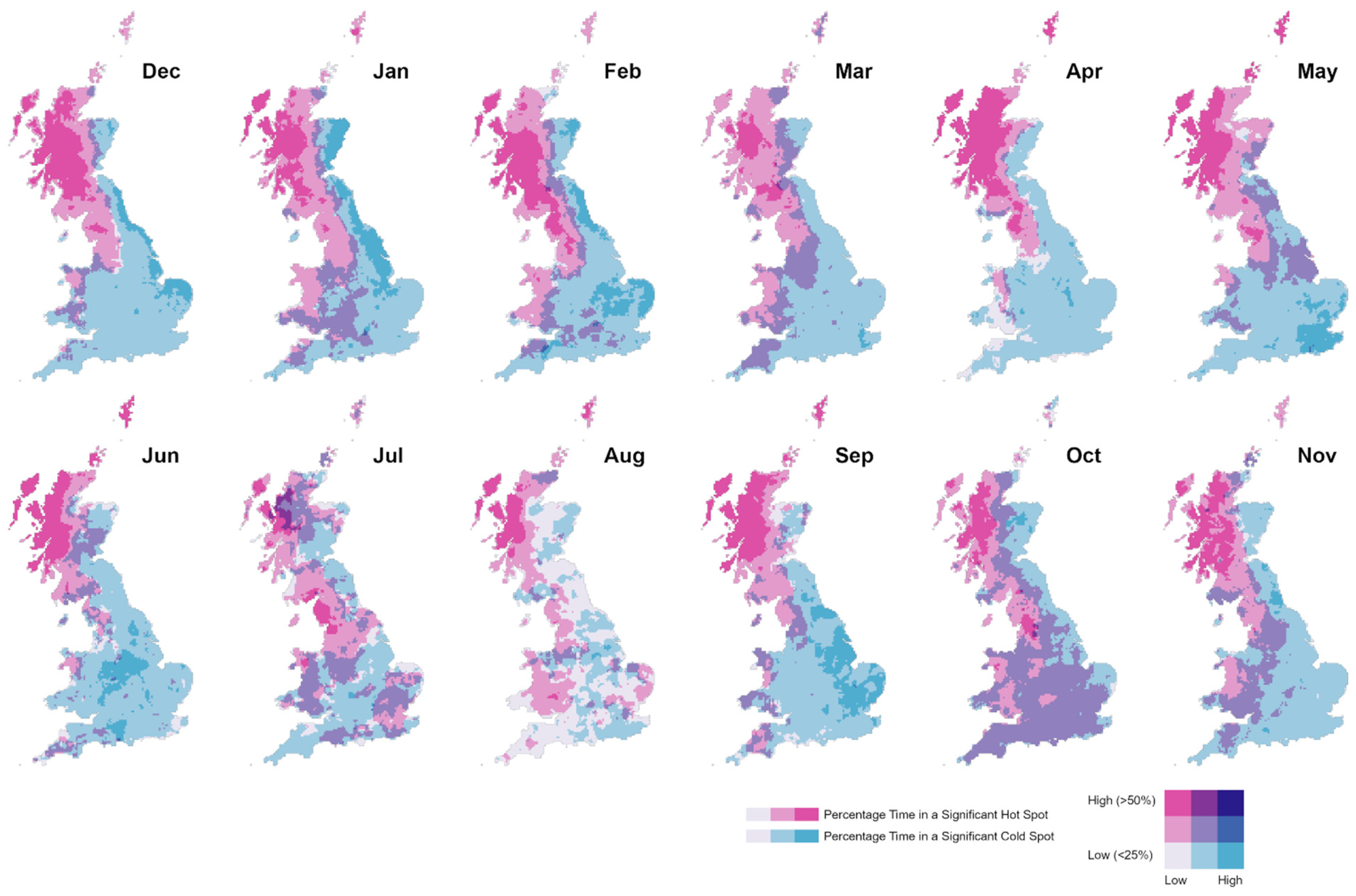
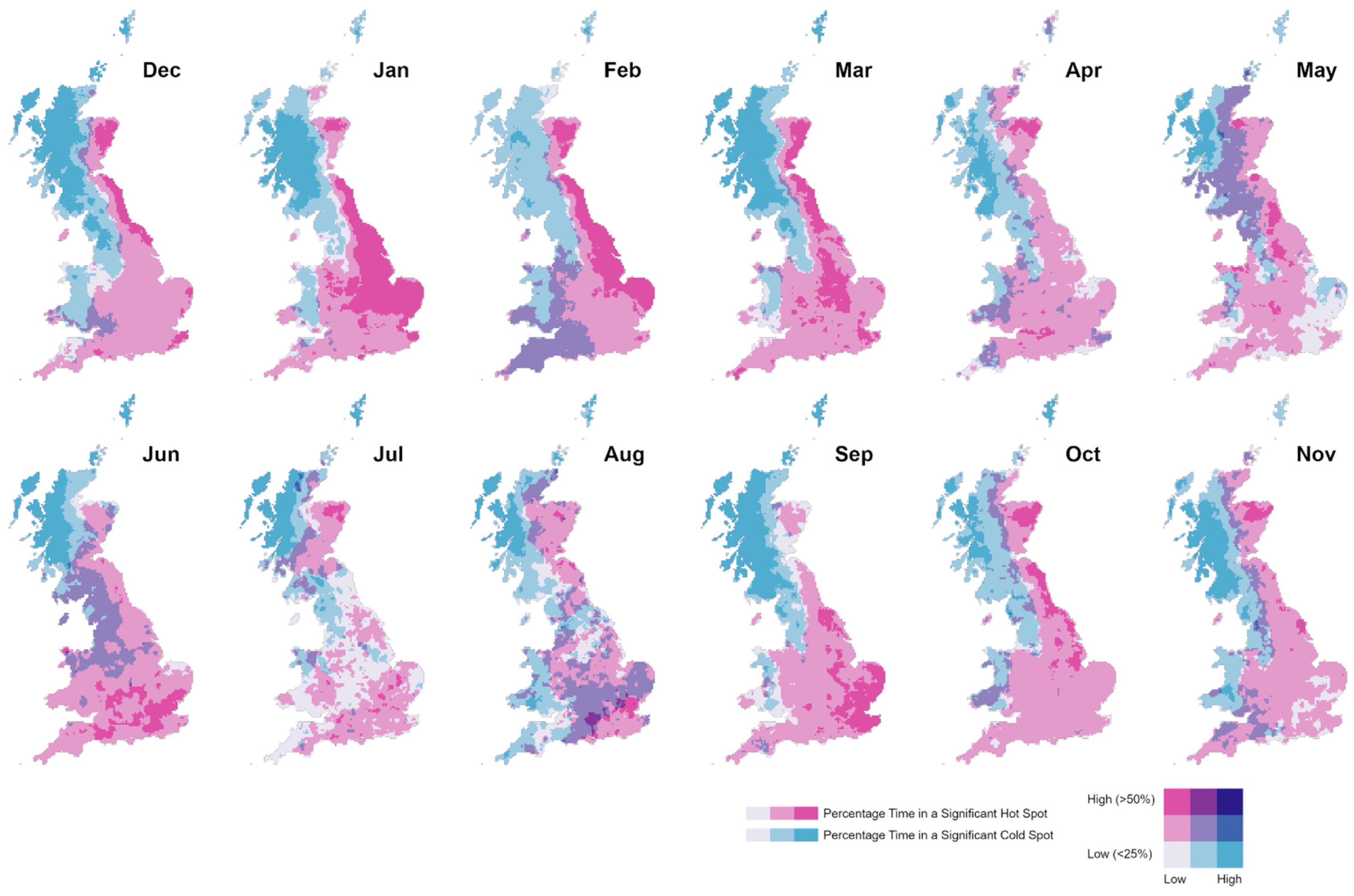
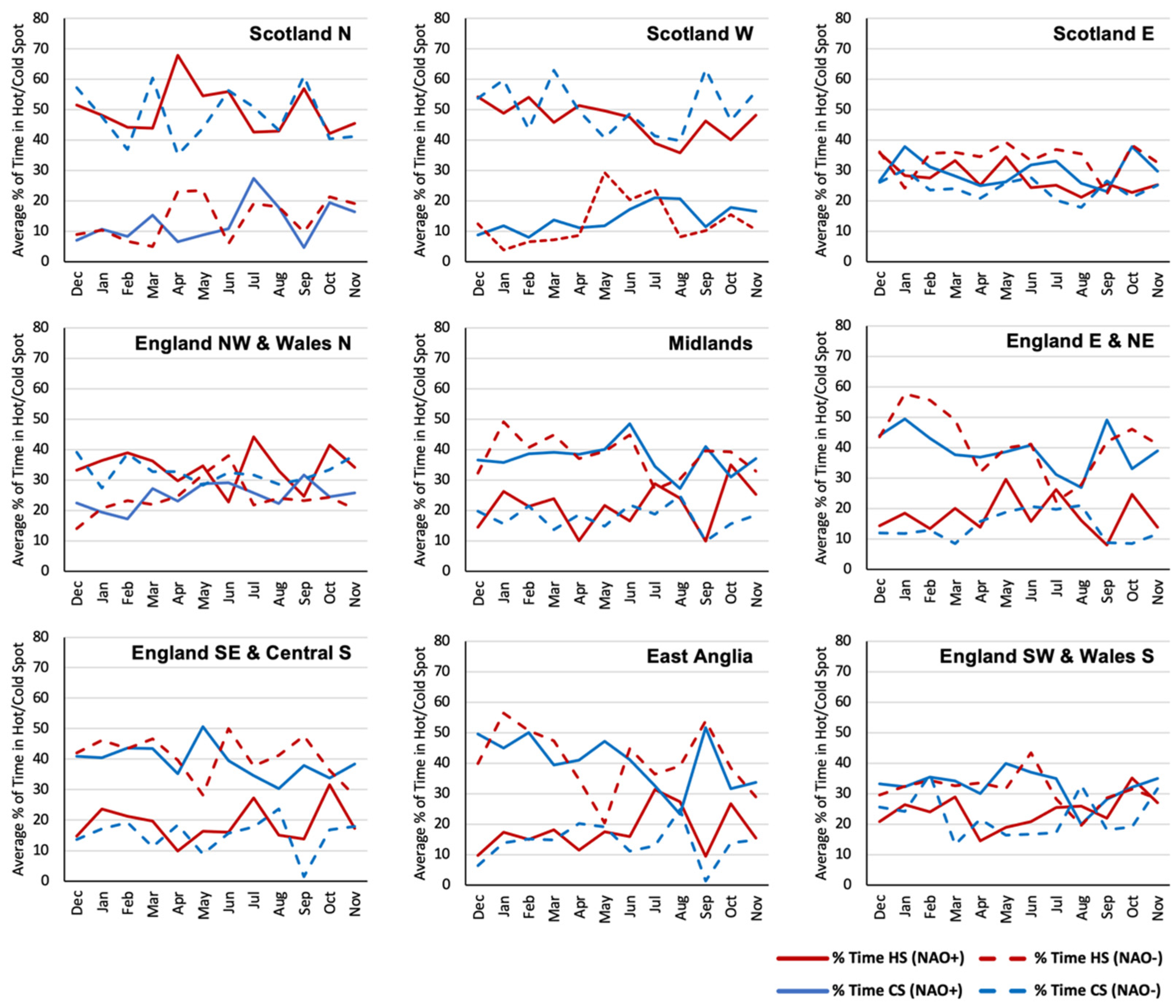
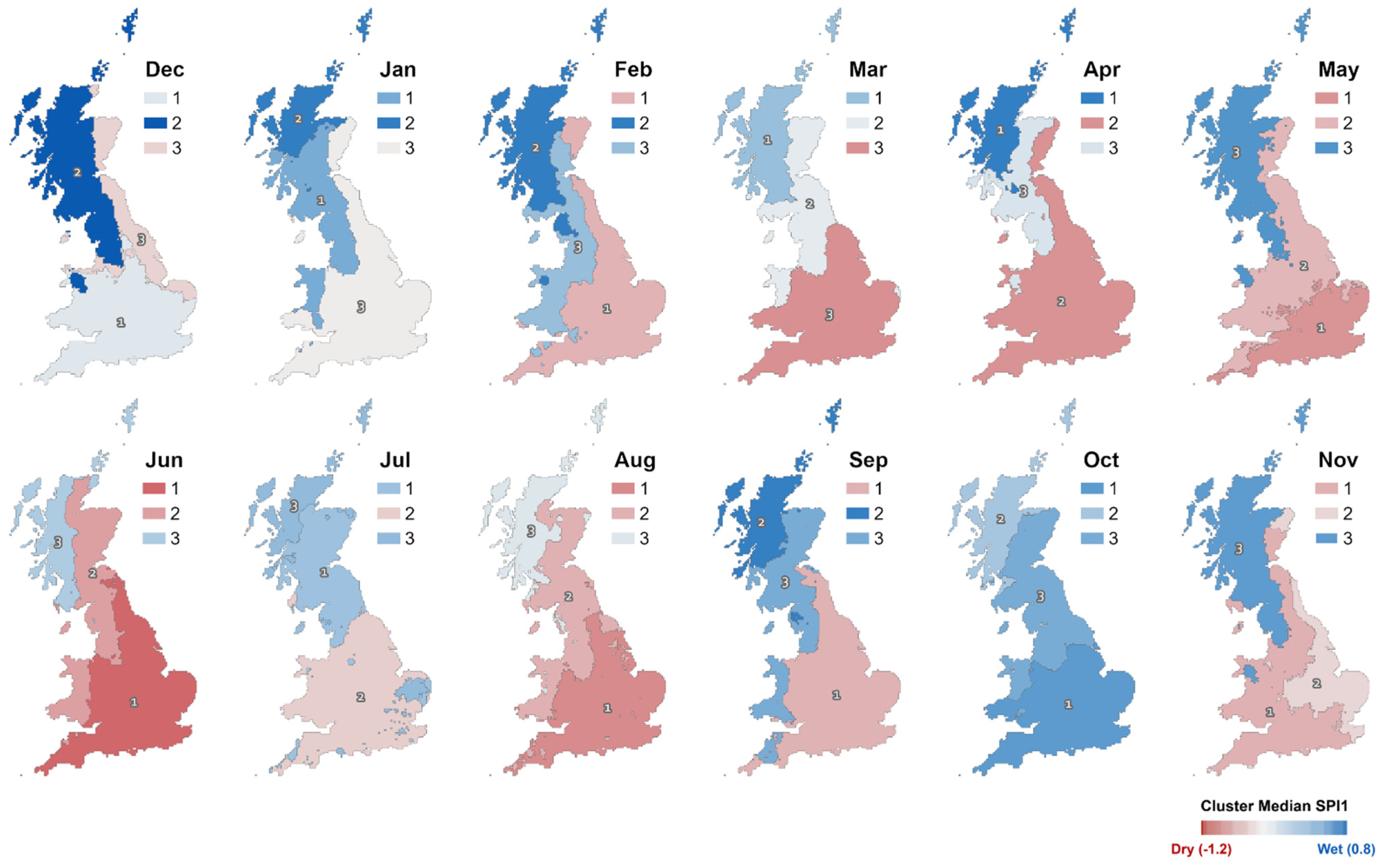
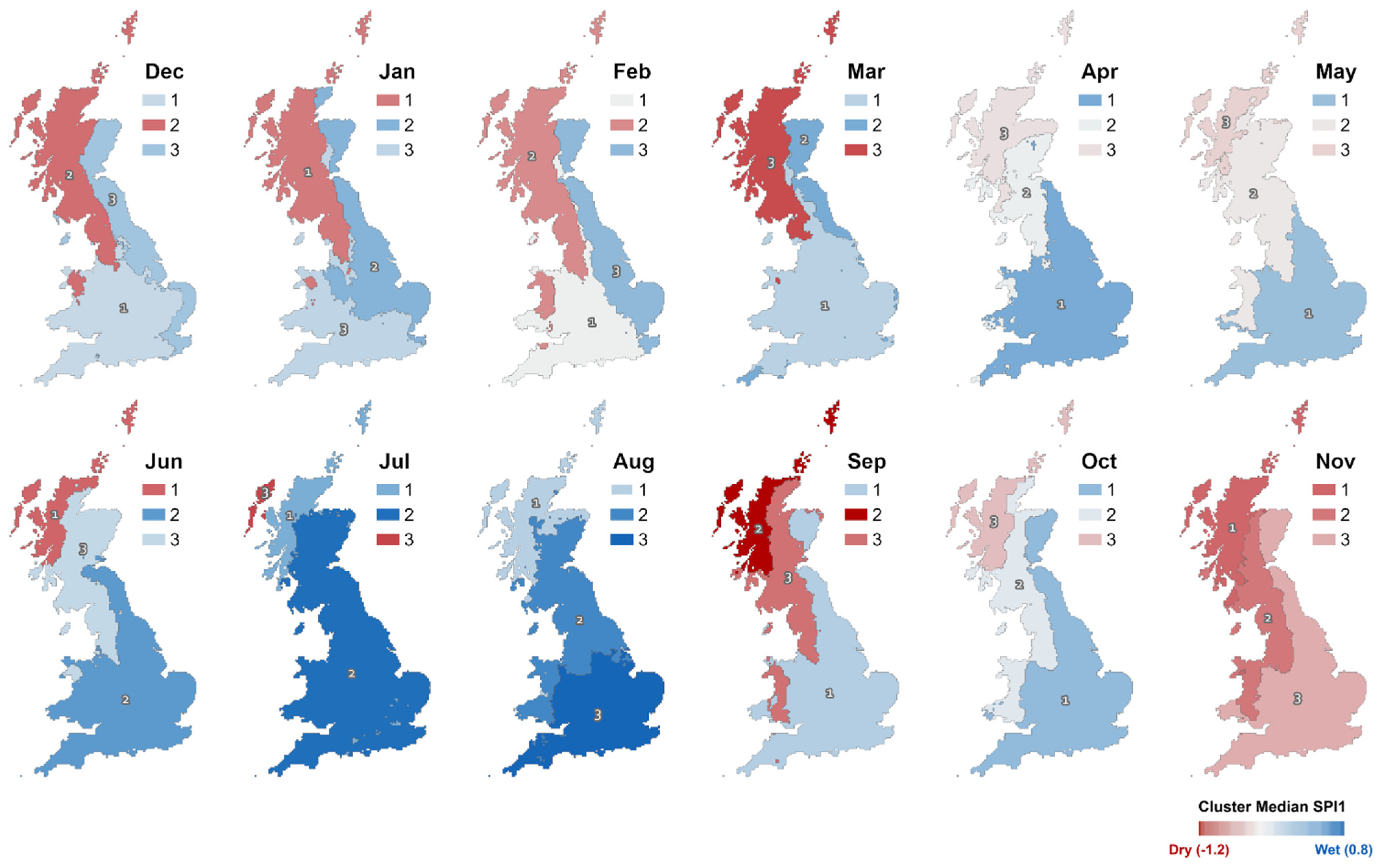
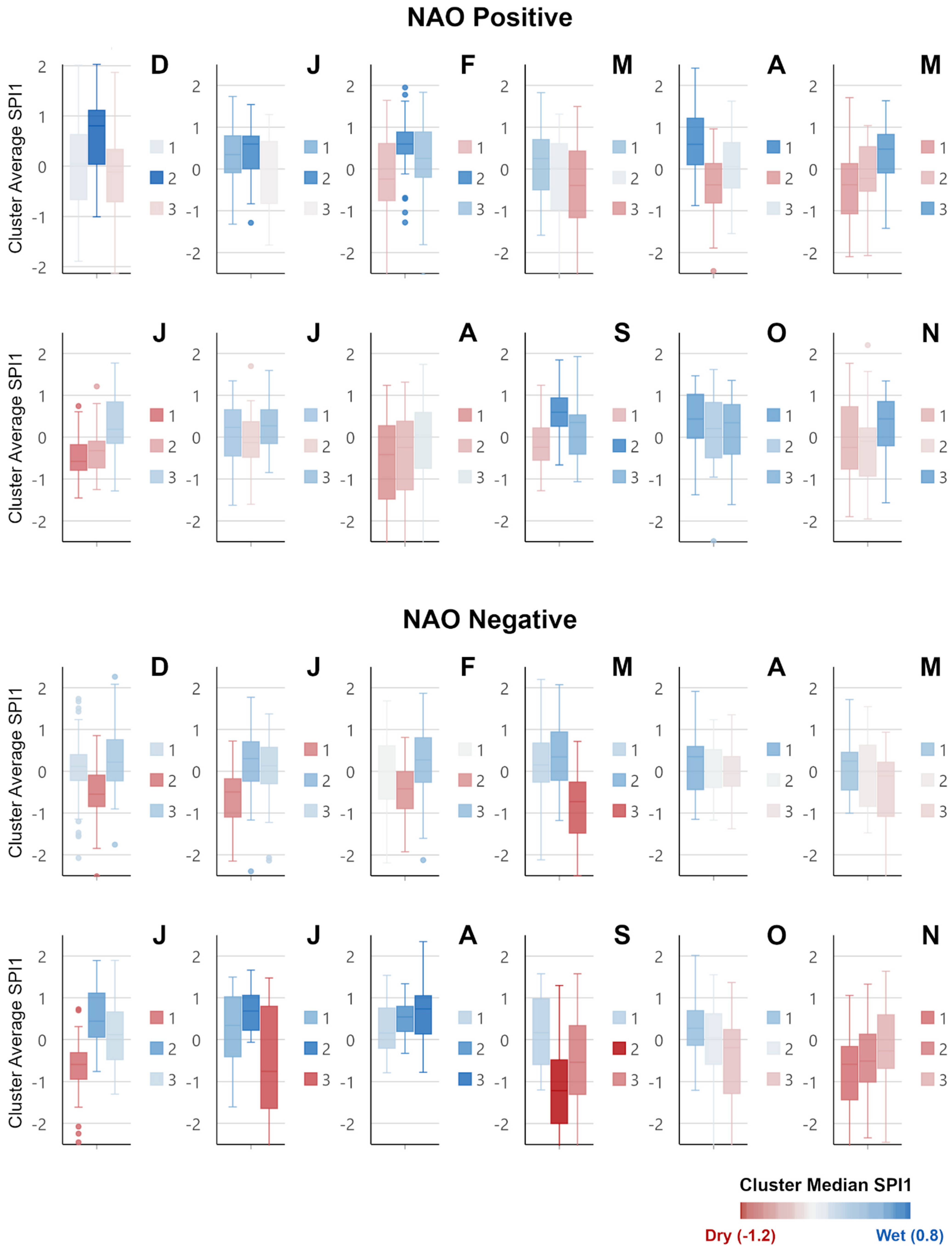
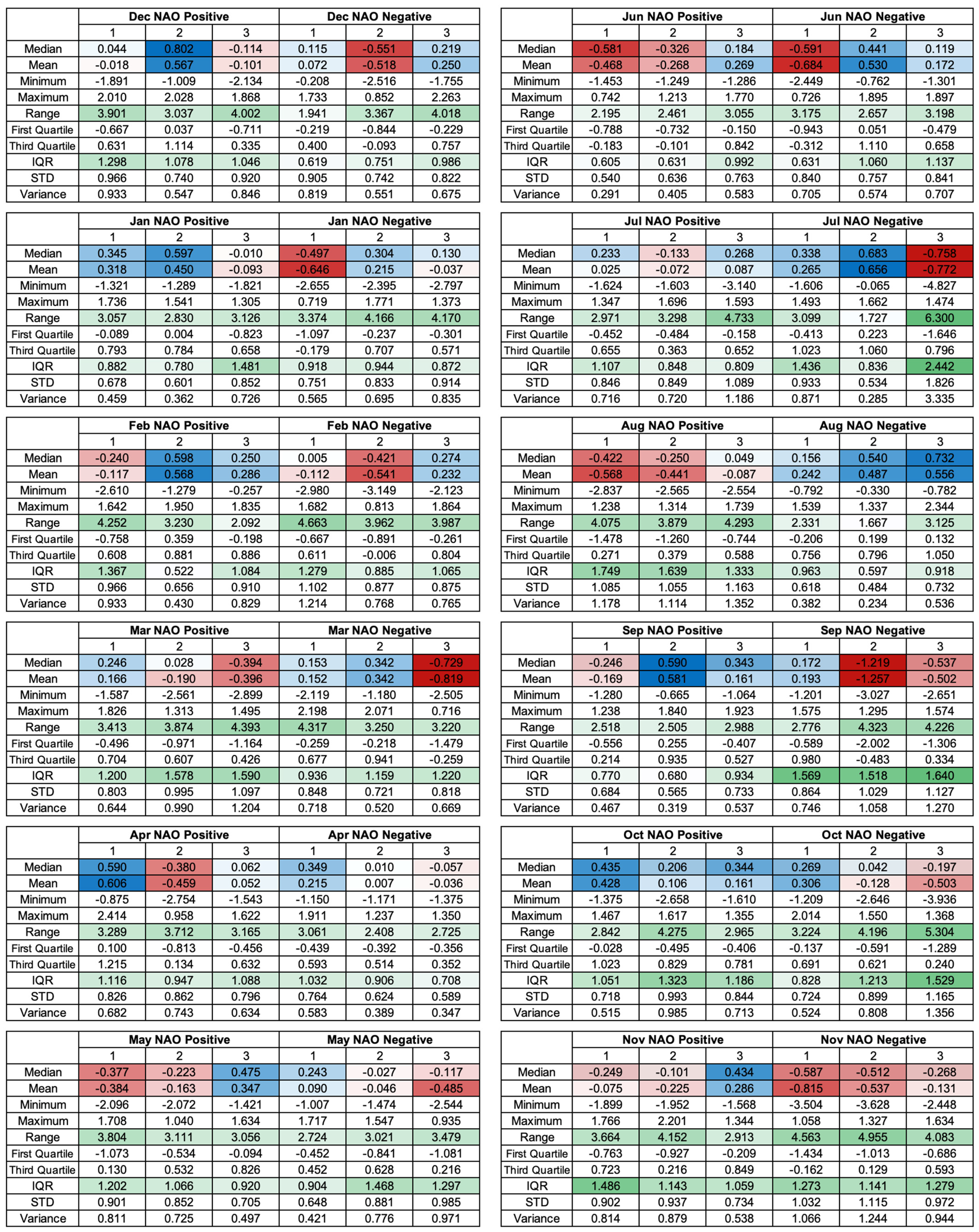
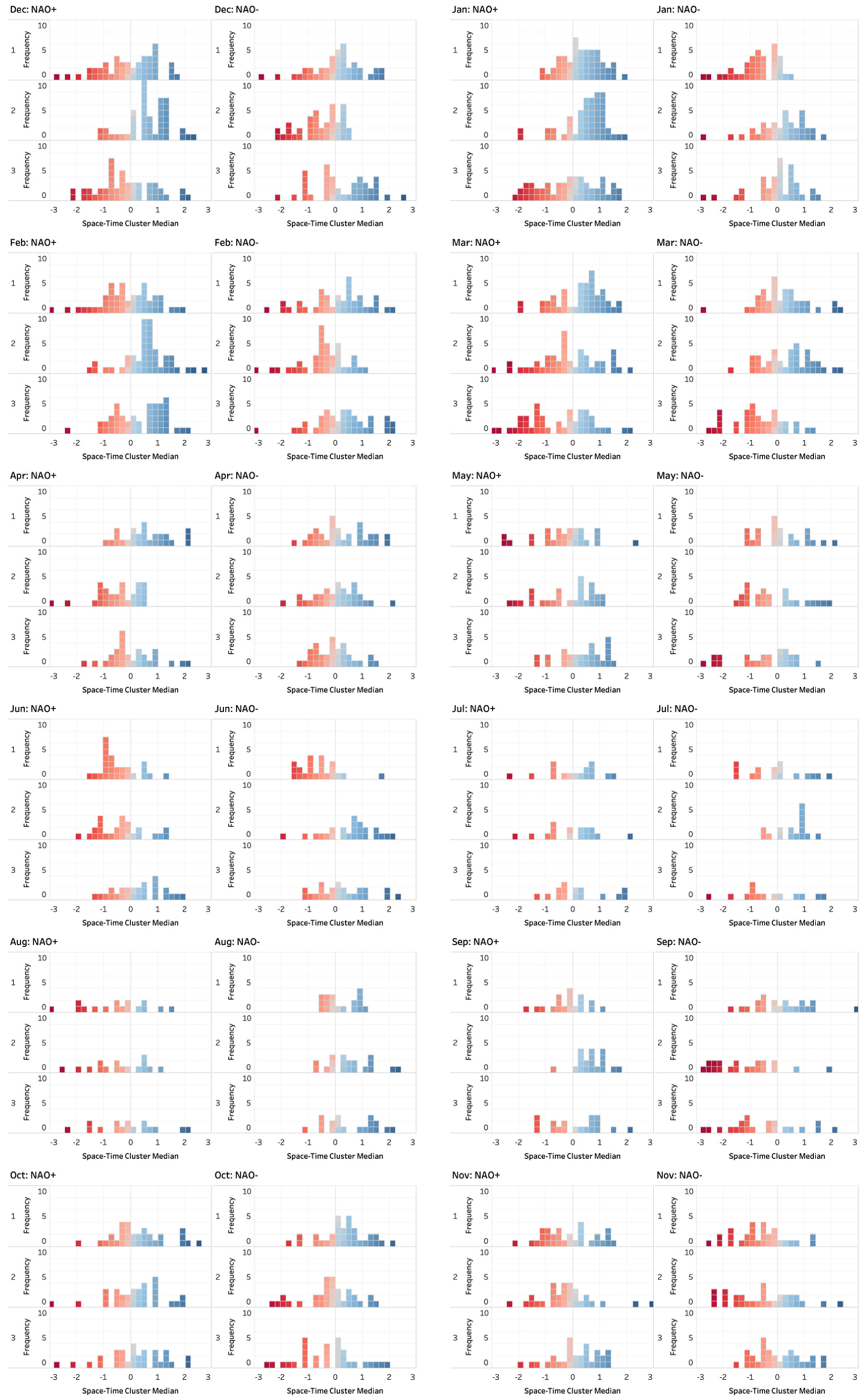
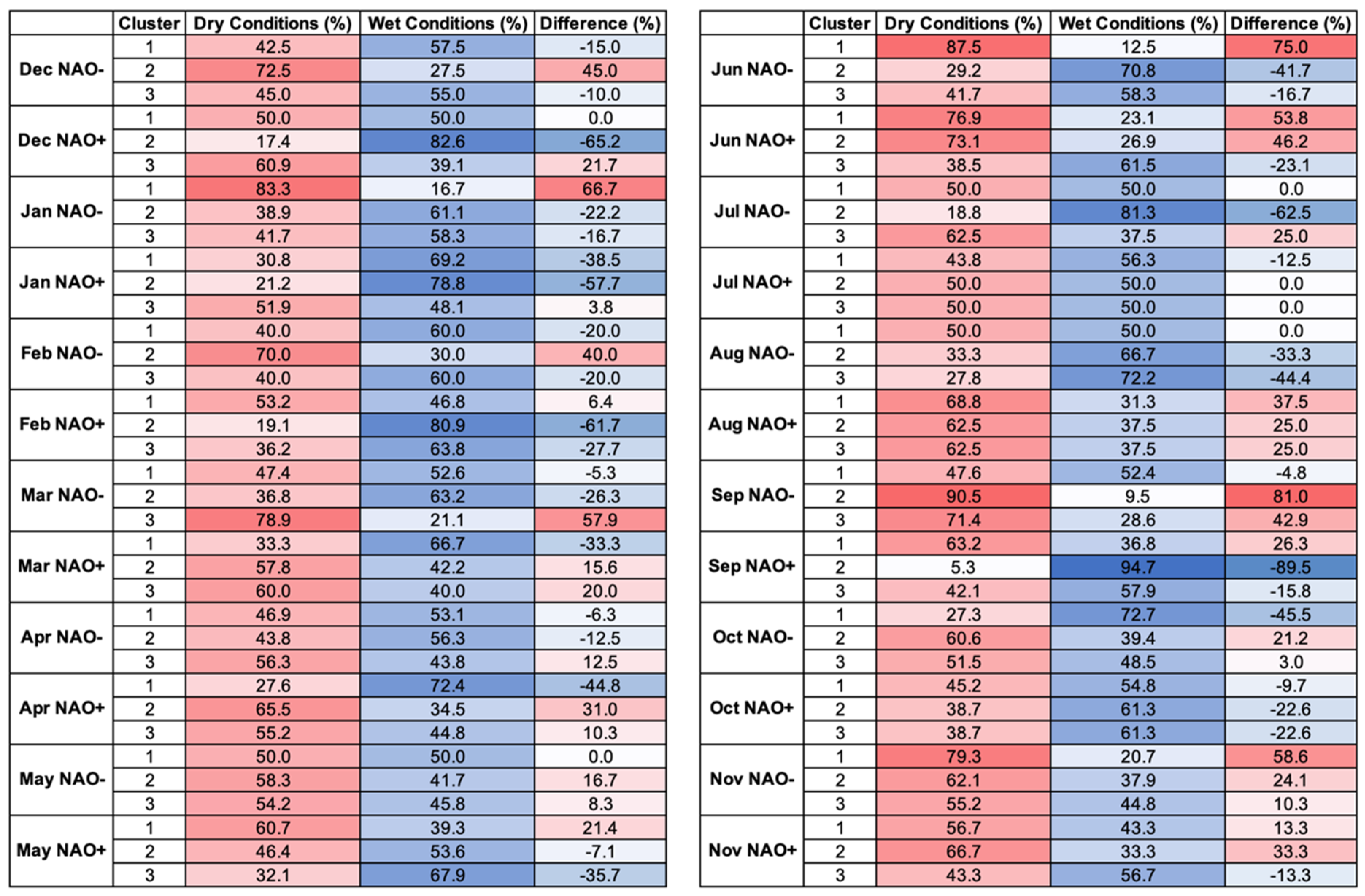
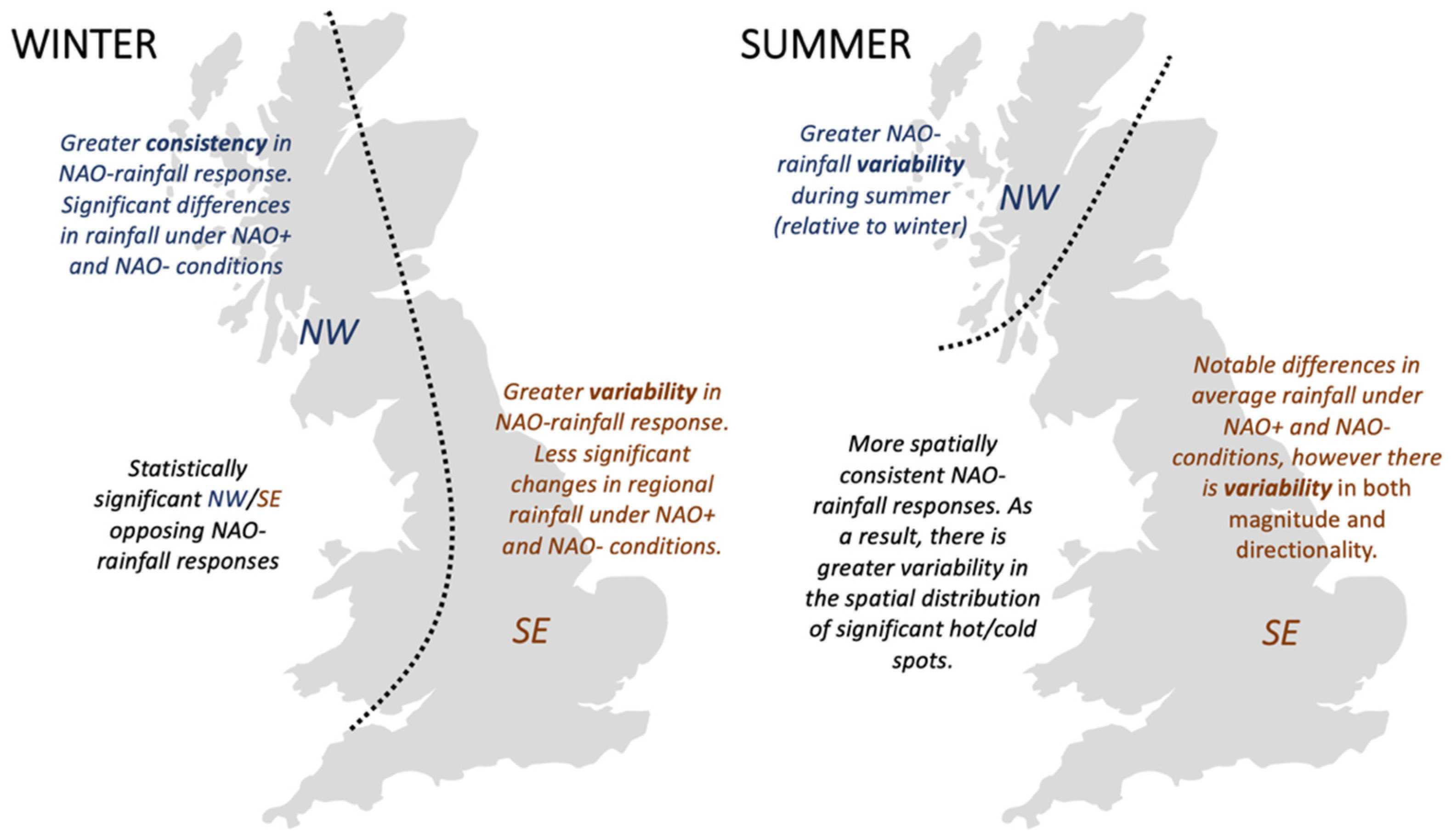
| Period | NAO+ Frequency | NAO− Frequency | NAO Neutral Frequency |
|---|---|---|---|
| Dec | 47 | 40 | 29 |
| Jan | 52 | 36 | 28 |
| Feb | 47 | 40 | 29 |
| WINTER | 146 | 116 | 86 |
| Mar | 45 | 38 | 33 |
| Apr | 29 | 32 | 55 |
| May | 28 | 24 | 64 |
| SPRING | 102 | 94 | 152 |
| Jun | 26 | 24 | 66 |
| Jul | 16 | 16 | 84 |
| Aug | 16 | 19 | 81 |
| SUMMER | 58 | 59 | 231 |
| Sep | 19 | 21 | 76 |
| Oct | 31 | 33 | 52 |
| Nov | 29 | 31 | 56 |
| AUTUMN | 79 | 85 | 184 |
| Qualitative Descriptor | SPI-1 Value Range |
|---|---|
| Extremely Wet | 2.0–5.0 |
| Very Wet | 1.5–1.99 |
| Moderately Wet | 1.0–1.49 |
| Near Normal | −0.99–0.99 |
| Moderately Dry | −1.49–−1.0 |
| Severely Dry | −1.99–−1.5 |
| Extremely Dry | −5.0–−2.0 |
Publisher’s Note: MDPI stays neutral with regard to jurisdictional claims in published maps and institutional affiliations. |
© 2021 by the authors. Licensee MDPI, Basel, Switzerland. This article is an open access article distributed under the terms and conditions of the Creative Commons Attribution (CC BY) license (https://creativecommons.org/licenses/by/4.0/).
Share and Cite
West, H.; Quinn, N.; Horswell, M. Spatio-Temporal Variability in North Atlantic Oscillation Monthly Rainfall Signatures in Great Britain. Atmosphere 2021, 12, 763. https://doi.org/10.3390/atmos12060763
West H, Quinn N, Horswell M. Spatio-Temporal Variability in North Atlantic Oscillation Monthly Rainfall Signatures in Great Britain. Atmosphere. 2021; 12(6):763. https://doi.org/10.3390/atmos12060763
Chicago/Turabian StyleWest, Harry, Nevil Quinn, and Michael Horswell. 2021. "Spatio-Temporal Variability in North Atlantic Oscillation Monthly Rainfall Signatures in Great Britain" Atmosphere 12, no. 6: 763. https://doi.org/10.3390/atmos12060763
APA StyleWest, H., Quinn, N., & Horswell, M. (2021). Spatio-Temporal Variability in North Atlantic Oscillation Monthly Rainfall Signatures in Great Britain. Atmosphere, 12(6), 763. https://doi.org/10.3390/atmos12060763






